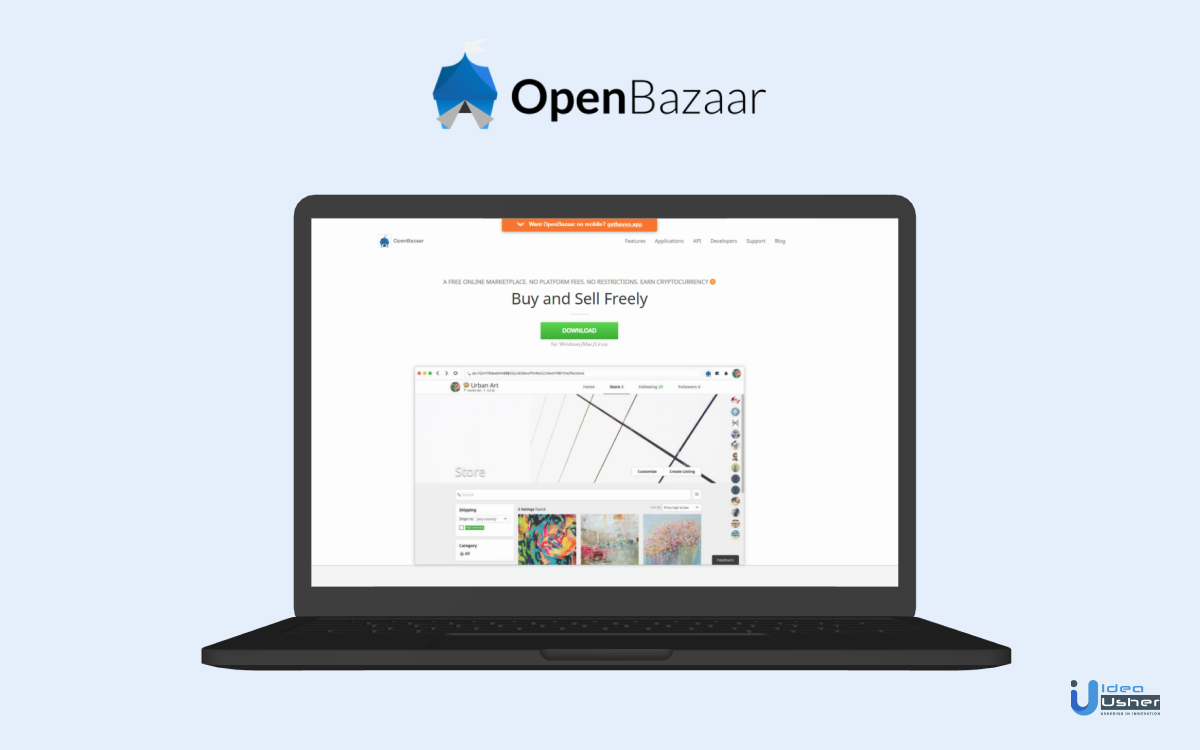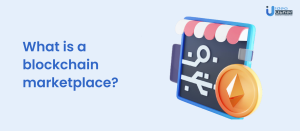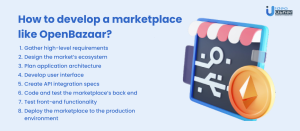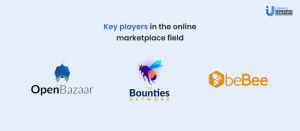
Wouldn’t it be great if we could do away with the middleman and just do peer-to-peer trading? OpenBazaar is just the platform for this. It is a decentralized e-commerce platform that allows users to list items for cryptocurrencies like Bitcoin. Have you ever wondered how to build an online marketplace on blockchain like OpenBazaar?
E-commerce provides tremendous benefits to traditional brick-and-mortar stores by allowing businesses to expand their reach and reach a much larger market exponentially. However, with such convenience comes a cost; this cost is paid to the third party, which essentially acts as insurance in mediating the payment. eBay, Amazon, Ali Baba, and other well-known centralized e-commerce platforms are examples. The issue with these e-commerce websites is that they charge exorbitant fees. Furthermore, because the dispute process is painfully slow, it could take weeks or even months to get your money back when a dispute arises.
What is OpenBazaar?
OpenBazaar is an open-source project that seeks to build a decentralized network for online peer-to-peer trading. It eliminates the middleman by connecting buyers and sellers directly via the OpenBazaar client. There are no fees associated with OpenBazaar because it is open-source and free to use.
| Original author(s) | Amir Taaki (DarkMarket), Brian Hoffman |
| Developer(s) | OpenBazaar Team |
| Initial release | 4 April 2016 |
| Written in | Go, JavaScript |
| Competitors | beBee, Bounties Network |
| Total nodes | 100K |
| Desktop app installs | 250K |
| Mobile app installs | 150K |
| Daily listings | >20K |
You can create a store in OpenBazaar and sell whatever you would like to reach a new audience. In return, you get paid in cryptocurrencies.
How does OpenBazaar work?
OpenBazaar is not a fee-based intermediary platform for buyers and sellers; it simply provides them with a client. Sellers create a listing for their product on this client, and other OpenBazaar users can view it. When a buyer and seller reach an agreement on a price, they are linked to finalizing the transaction.
Payments are only made in Bitcoin because Bitcoin is similar to OpenBazaar, an open-source, decentralized service that charges a minimal fee, is not run by a central authority, and allows for instantaneous value transfer.
What is a blockchain marketplace?

A blockchain marketplace is a peer-to-peer system that eliminates the middleman by incorporating the ledger’s transparency and a layer of trust. The transaction in a blockchain marketplace is one-on-one, with no centralized authority taking their cut.
And, for the first time in history, this is possible because we now have technology that eliminates the need for trust. Because of its transparency, every transaction–every relevant detail about a service provider and a seller–can be seen. There can be no falsification or tampering with reviews. They are genuine, unchangeable, and will exist in perpetuity on the blockchain.
Furthermore, because a blockchain marketplace employs smart contracts, there is no payment issue. The transaction occurs once the terms are agreed upon. Simple and trouble-free.
And, because the transaction is truly peer-to-peer (rather than being marketed as such by the current sharing economy), prices are lower all around, and the decentralized nature of blockchains means there is no single point of failure or weakness.
The following are the main components of a blockchain marketplace:
- Payment Guaranteed with Trust
- Transparency
- Lower prices
- Decentralization
Blockchain can be used in almost any industry, from freelance work to finance, grocery shopping, and lodging rentals.
Advantages of decentralized marketplaces
- Lower fees and lower prices
- Unlimited buy and sell option
- No chance of chargeback fraud.’
- Flexible terms
- Payment without the involvement of any middlemen
- Easy Dropshipping
- Users have control over their personal data, while sellers have control over their brands.
How to build an online marketplace on blockchain like OpenBazaar in 8 steps?

So, now that we are introduced to OpenBazaar, the next step in the process is how to build an online marketplace on blockchain like OpenBazaar. Here are a few brief steps to be followed during the development process:
- Find the purpose and define the scope of the project
- Proof of concept & technical feasibility verification
- Solicit feedback from experts in the field- and follow agile practices
- Team building for design and development
- Product launch and release
- Market the final product
Next, we come to a more detailed overview of the development process.
1. Gather high-level requirements
The first step is to define functional requirements for your decentralized marketplace. Then define use cases and user journeys for what it should be able to do.
After that, break these use cases down into smaller tasks and lay out a timeline for building the product from start to finish. For instance, you might want zero commission fees and a peer-to-peer transaction system with open-source code as one of your end goals. That means you would need an open-source code team that can create this as well as other development teams working on creating a peer-to-peer transaction.
2. Design the market’s ecosystem
There needs to be a set of rules in place about adding NFTs or other products on the marketplace, registration process, etc., before they can be used by buyers and sellers worldwide.
A decentralized marketplace has no servers or centralized controlling entities, so there are no third-party fees. It is designed to prevent censorship and allow buyers and sellers from all over the world to trade without restriction at a low cost without any middleman interference.
This decentralized way of running markets has its own set of benefits and drawbacks. It is important for one to design an ecosystem where people can trade freely without being restricted by unnecessary regulations or having to go through a complicated registration process just to access the marketplace.
3. Plan application architecture
The next step is to understand app architecture and how to apply it to your use case. There are many components in the OpenBazaar architecture. The two most important ones are the Transaction Server and Market Server. These servers can run on separate machines or on different virtual private servers (VPS) within the same physical machine, and they share resources like memory and CPU based on demand.
The OpenBazaar architecture consists of four layers:
- Network,
- Transaction Server,
- Market Server, and
- Client Interface/UI layer.
This layered approach enables the system to scale to meet increasing demand without compromising its performance or security.
4. Develop a user interface
The interface should be clean and user-friendly. It should provide the user with all the required information and make it easy to scan through the items in a shop. The interface should also be responsive and adaptable to different screen sizes.
5. Create API integration specs
Developing API integration specs is important if you want to make sure that your marketplace has all the features users expect. This API spec should include the data types, response formats, and response codes. You also need to make sure that you are capable of integrating these API specs with your marketplace’s backend microservice code.
The main problem with OpenBazaar is that sellers are not able to offer their products for sale across different online marketplaces at the same time. This means that they have to create a separate store for every marketplace they want to be on. It leads to increased marketing costs and loss of revenue from missed marketing opportunities. OpenBazaar does allow users to integrate their shop into another website, but this integration process is more difficult than it should be. The company should make it easier for users of other websites or app stores to integrate with OpenBazaar.
6. Code and test the marketplace’s back end
It is important that we focus on testing the marketplace’s back end. Testing should be done in an agile manner: testing one piece of code at a time and then moving on to another piece. This helps us find bugs in our code faster. Code can be tested by running automated tests or by having developers manually check its functionality using the command-line interface (CLI). The OpenBazaar team has created automated tests for each function in their Marketplace API so that they can quickly identify bugs when they introduce new features or changes.
OpenBazaar is an open-source project which is trying to accomplish the feat of creating a more open, accessible, and inclusive e-commerce system that can provide frictionless trade by combining BitTorrent architecture with Bitcoin transactions.
We will use the OpenBazaar codebase as a starting point and then customize it for our own use case. This is a new way to set up a marketplace that is more transparent and decentralized.
The OpenBazaar client software is fully open-source and available to download for free. The client uses a peer-to-peer network similar to BitTorrent and relies on the security of public-key cryptography, making it difficult for anyone to shut down the marketplace.
7. Test front-end functionality
The first step of testing a decentralized marketplace is to test its front-end features, including adding items, listing them on the store, and buying them back.
Test transactions:
After ensuring that the basic functionalities work correctly, it is time for testing transactions so that we can ensure everything works fine when users purchase items from the marketplace.
To create a decentralized marketplace on the blockchain, you need to first create an account, then download wallet software, and make sure the software works by registering on testnet. Then you are ready to trade goods with other users in your market.
8. Deploy the marketplace to the production environment
The next step is then to deploy your solution in a production environment. While it is often relatively straightforward to set up a development system, a production system is however much more complex. It needs to span multiple organizations and integrate them into their existing infrastructure.
This requires each organization to perform some integration and administration work both internally and in collaboration with the other blockchain members. There are a few things that need attention before deploying it successfully.
- Firstly, you need to set up an internet connection between machines running your nodes so that they can talk to each other because they will be acting as autonomous peers in the marketplace.
- Secondly, you need a way for ethereum clients to use your nodes as peers in order to verify ownership of ERC721 tokens.
Cost of building an online marketplace
Once you know the process of how to build an online marketplace on blockchain like OpenBazaar, the next question occurring to you must be the cost of developing this.
The cost of developing a blockchain MVP marketplace will vary depending on your location and the associated manpower costs. Also, keep in mind that Ethereum DApp development is a specialized skill, and experienced developers are hard to come by because they are in high demand. The cost of manpower may rise as a result of this. You can read the cost of building a blockchain project here.
Top 3 key blockchain online marketplaces

1. OpenBazaar
OpenBazaar is probably the most well-known decentralized marketplace for online buying and selling. You can list whatever you want and pay in 50+ different cryptocurrencies (at first, only Bitcoin was accepted) with no transaction fees. To use OpenBazaar, you must first download a program to your computer. This is done to keep OpenBazaar as free of centralized bodies as possible.
| Pros | Cons |
| OpenBazaar is a peer-to-peer network, meaning one central organization doesn’t have total control over the listings. | For merchants, there are tons of fancy features available to use, with some features not even deployed by some of the other mainstream marketplaces yet. You have access to inventory tracking, a live chat application, various shipping options, product variants, and order management systems. |
| Due to the absence of the middleman in blockchain networks, transaction fees become much lower. | There is a lack of an internal currency. Bitcoin provides immediate liquidity, and that is good for sellers, but having an internal currency is a win-win situation for early adopters and the developers themselves. |
2. beBee
beBee is a personal and professional branding platform that is built on the Origin protocol. If you’re looking for a comparison, consider beBee to be the LinkedIn of blockchain. It already has thousands of users, including individuals and forward-thinking companies such as Deloitte, Hubspot, and Oracle.
beBee users can share and promote their personal brands and portfolios. This allows them to market themselves to employers, customers, and clients, as well as media and vendors, using a pull marketing strategy rather than a push marketing strategy.
| Pros | Cons |
| Easy to use on the smartphone | Limited control of the mobile listing |
| Events can be live-streamed whenever you want. | Clunky design and feel with not a lot of customization options |
| Only relevant topics and people showed on the feed. | Difficult to use the messaging function |
| Stories can be written with an on-site blogging tool, and you can share your knowledge with millions of customers. | No mobile account option |
3. The Bounties Network
The Bounties Network’s founder believes that in the not-too-distant future, we will be able to bounty out any task imaginable.
They currently have a user base in the thousands, and bounties include content and design work, translation, and programming. However, the team is currently working on allowing businesses to bounty out entire processes and departments. Consider recruiting, advertising, or programming.
All users payout and receive bounties in ETH, with the wallet initially pre-loaded. As a result, unlike some freelance work sites today, freelancers can be confident that their payment is secure. To use Bounties and see what’s on offer, install Metamask in your browser.
| Pros | Cons |
| Easy verification. | Sometimes your stream isn’t active enough or nobody wanted to follow you there |
| Works well on your smartphone | Not enough bounty campaigns out there |
| You can create a channel or a stream that teaches something you know well | Usual payment takes a long time. |
| The community is nice, and the app has a fun vibe. | |
| The app is made well, and it’s easy to use |
Final thoughts
We hope that the blog answers the pertinent question of how to build an online marketplace on blockchain like OpenBazaar to some extent.
Decentralized marketplaces are the future. They offer the potential to create a more open, accessible, and inclusive e-commerce system that can provide frictionless trade.
Blockchain is one of the most promising technologies for the next decade. It will help us decentralize all kinds of information and make it more available for everyone in a secure way.
With blockchain soaring high, this is the right time to jump on the bandwagon. While blockchain marketplaces are yet to achieve perfection, they are, however, increasing in strength, and once people realize that we no longer require the centralized companies in the middle, it may be a case of the bigger they are, the harder they fall.
At Idea Usher, we have visionaries in the form of designers and developers with years of experience working in the crypto world. They are knowledgeable with all of the most recent highlights imbued in the decentralized marketplace development. With our assistance, financial backers will be able to create their own marketplace. We have professional designers on staff who have previously assisted a number of startups in the development of blockchain marketplaces. Take advantage of this opportunity to connect with us for significant additional benefits in fostering your business development. For a quote, please contact us at [email protected] right away.
FAQ
Q. How does a decentralized marketplace work with blockchain?
Blockchain-based or decentralized marketplaces, on the other hand, are peer-to-peer networks that connect buyers and sellers directly without the use of intermediaries. A decentralized marketplace brings together three types of users: producers, sellers, and buyers.
Q. Why should you think about implementing blockchain technology in your company?
A blockchain-based marketplace is hosted and supported by its users’ computing power. This continuous upkeep ensures that a marketplace is always accessible. Furthermore, rethinking how data hosting is organized can result in increased security, privacy, and transparency.
Q. What is the problem with online marketplaces?
With the advent of the internet, large online markets that connect buyers and sellers of physical goods emerged. These marketplaces also provide payment services, making it simple to pay for transactions. However, these marketplaces have proven to be far from perfect:
- Because money is exchanged before goods are exchanged, they are prone to fraud. Even though online markets provide ways for buyers to receive compensation if something goes wrong, they are far from ideal
- buyers, and sellers will have to comply with the terms of agreements (which may change over time) and share personal information.
- They will also have to pay a fee to the platform whenever a product is sold and use a third-party payment system that is linked to their preferred marketplace.
- Buyers’ personal information can be hacked or stolen, and it’s unclear how a platform uses such information. As a result, a traditional marketplace becomes a “black box,” acting as a middleman between buyers and sellers.
Q. How can blockchain solve the problem of online marketplaces?
Blockchain technology was created to address issues related to digital payments. By removing the traditional “middlemen,” such as the aforementioned traditional marketplaces, a situation was created in which buyers and sellers are directly connected. This would eliminate many of the uncertainties and dependencies that both parties face when using traditional marketplaces.
But that’s not all: blockchain technology was created to act as a secure payment mechanism as well as to provide buyers and sellers with the information they need to complete a transaction, providing both parties with a “single source of truth” as a guarantee (or contract) that commits both parties to complete a transaction. In other words, blockchain technology combines a secure payment mechanism with mutual agreement between buyers and sellers. This is possible because the blockchain automatically registers (timestamped) metadata about transactions, which is shared with all stakeholders, making it impossible to manipulate data without the knowledge of other stakeholders.
It is precise because of this built-in security that blockchain technology is a good fit for online marketplaces. It gives buyers and sellers the trust that is lacking in traditional marketplaces: transparency for both transactions and agreements is what distinguishes blockchain technology, with additional security guarantees for both when making a payment. That means that an escrow service, in which a third party can intervene when a dispute arises, is no longer required because transparency is always guaranteed.













Shrestha Bhadra